The Economics and Statistics Division maintains archives of previous publications for accountability purposes, but makes no updates to keep these documents current with the latest data revisions from Statistics Canada. As a result, information in older documents may not be accurate. Please exercise caution when referring to older documents. For the latest information and historical data, please contact the individual listed to the right.
<--- Return to Archive
For additional information relating to this article, please contact:
November 19, 2024LIFE SATISFACTION AND QUALITY OF LIFE, Q3 2024 Statistics Canada has updated and expanded data about how Canadians perceive their quality of life. This information is collected as part of the Canadian Social Survey, conducted from Jully-September 2024. National data does not include any results from the Territories.
This survey reports on Canadians' overall satisfaction with life, sense of meaning and purpose, hopeful future outlook, loneliness, having someone on whom to depend on when needed, sense of belonging to community, satisfaction with time use, satisfaction with local environment, confidence in institutions, trust in people and experiences of discrimination. Results are stated as the share of the population reporting. Not all indicators of quality of life were surveyed in each period.
Life satisfaction
In Nova Scotia, 47.3% of respondents rated their life satisfaction in the most satisfied categories (8-10) while 25.4% responded with the least satisfied categories (0-5). Across Canada, 46.8% of the respondents were in the most satisfied categories while 24.3% were in the least satisfied categories. High life satisfaction (8-10) was most prevalent in Québec while it was least prevalent in Alberta. Low life satisfaction was most prevalent in British Columbia and Alberta and least prevalent in Québec.
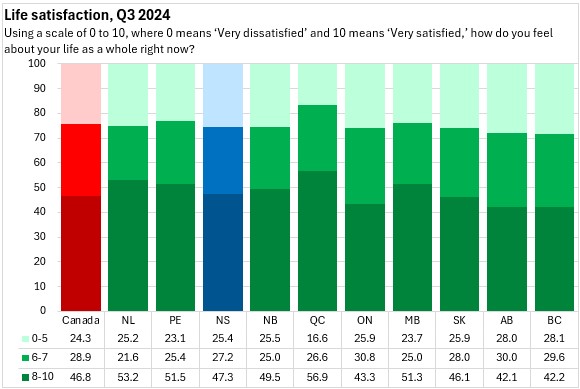
In Nova Scotia, life satisfaction has been trending down in recent years. There was a notable deterioration in reported life satisfaction in Q2 2024, but this has recovered somewhat in the most recent data.

Sense of Meaning and Purpose
In Nova Scotia, 57.1% of respondents replied in the three strongest categories (8-10) for sense of meaning and purpose. Across Canada, 55.6% reported the strongest sense of meaning and purpose. The highest share of respondents in these categories were in Québec.
19.4% of Nova Scotians responded that their sense of meaning and purpose in the things they do in life were in the lowest categories (0-5). The national average response in the lowest categories was 18.7% with weak sense of meaning and purpose most prevalent in Alberta and British Columbia.
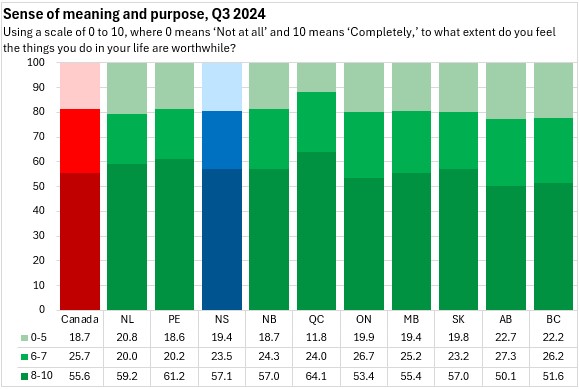
In Nova Scotia, sense of meaning and purpose declined in Q2 2024 before recovering in Q3.
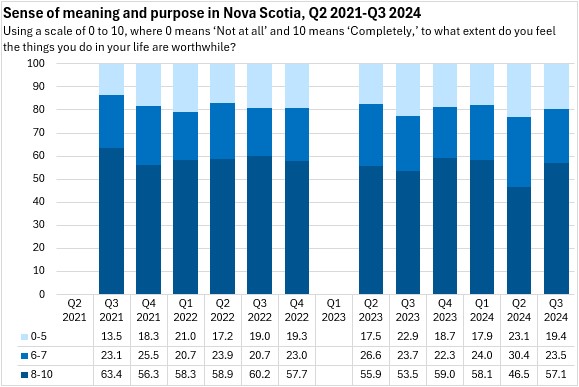
Hopeful Outlook for the Future
53.7% of Nova Scotians reported feeling hopeful about the future always or often while 17.1% of Nova Scotians rarely or never felt hopeful about the future. Respondents in Nova Scotia had the highest prevalence of rarely/never feeling hopeful about the future. Respondents in Québec were most likely to report always having a hopeful outlook for the future.
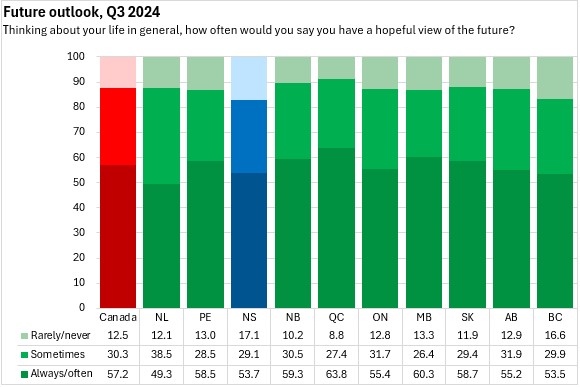
The prevalence of a hopeful outlook has eroded in recent years, though there was some improvement in Q3 2024.
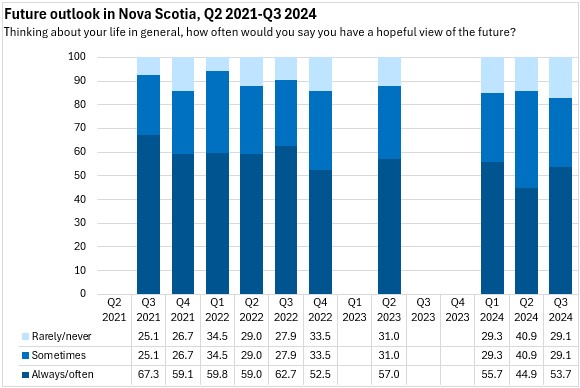
Loneliness
In Nova Scotia, 50.4% of the population reported rarely or never feeling lonely. A further 36.2% reported feeling lonely sometimes while 13.4% reported feeling lonely often or always.
Nationally, 53.3% of the population are rarely or never lonely, 34.0% are lonely sometimes and 12.8% are often or always lonely. The share of the population that are rarely or never lonely was highest in Québec and lowest in Alberta. The share of the population reporting frequent loneliness was highest in New Brunswick and lowest in Manitoba.
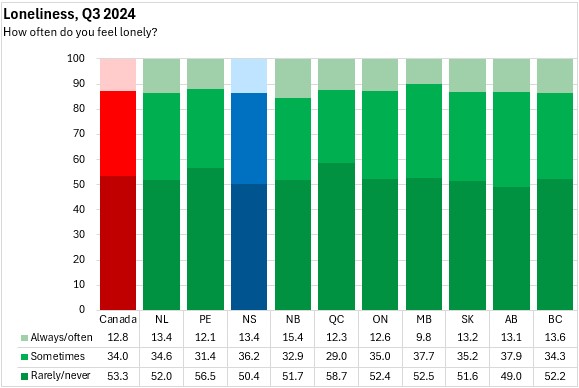
Over the last 3 quarters, there has been some increase in Nova Scotia's share of the population that report sometimes feeling lonely.
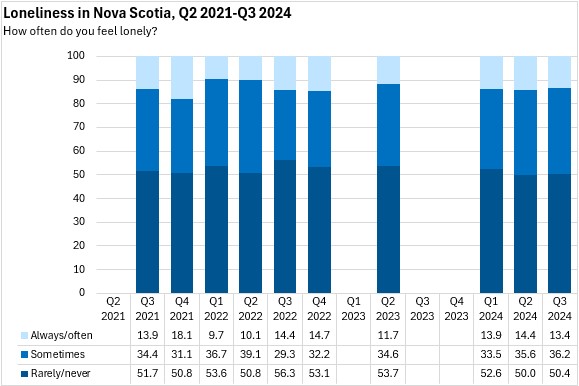
Someone to Depend on When Needed
In Nova Scotia, 77.3% of the population felt they always or often had someone on whom to depend when needed. Across Canada, 73.7% of respondents felt they always or often had someone upon whom to rely (highest: Québec; lowest: Ontario).
7.9% of Nova Scotians felt they rarely or never had someone upon whom to rely. Nationally 8.2% of the population rarely/never has someone on whom to rely (highest: Saskatchewan; lowest: Manitoba).
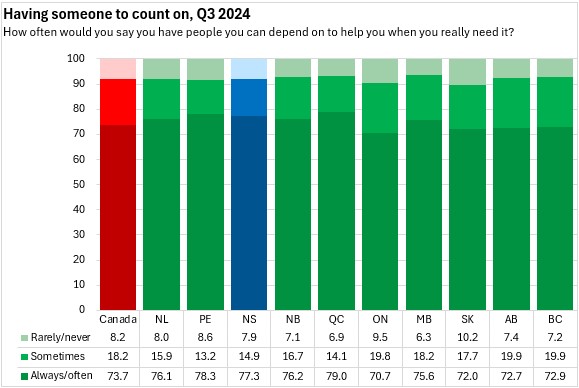
At one point, Nova Scotians were among the most likely to report always or often having someone upon whom to depend. This eroded from 2022-2024, but has improved since the beginning of the year.
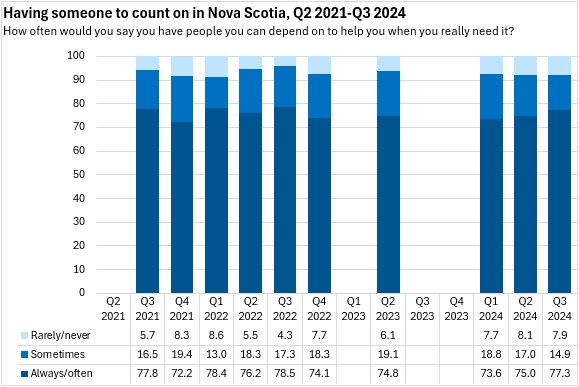
Sense of Belonging to Community
In Nova Scotia 50.9% of respondents indicated a somewhat or very strong sense of belonging to their community - below the national average of 51.9% of Canadians. Only Ontario reported a lower share of respondents than Nova Scotia with a strong or very strong sense of belonging to community.
In Nova Scotia, 34.8% of respondents reported a somewhat or very weak sense of belonging to community - the second highest prevalence among provinces (after British Columbia).
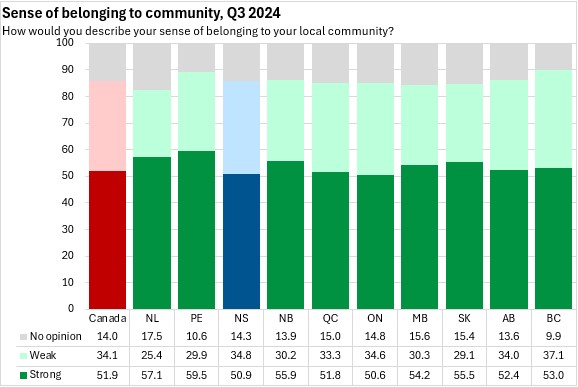
Nova Scotia's sense of belonging to community declined from Q4 2022 to Q2 2023, it has recovered partially in recent data.
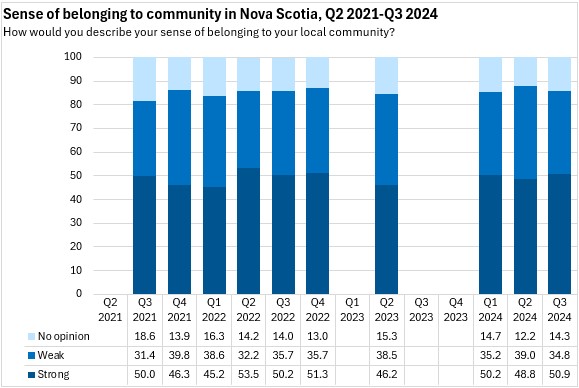
Satisfaction with Time Use
In Nova Scotia, 36.5% of respondents reported low satisfaction with time use (0-5). This was above the national average of 35.5%. Low satisfaction with time use was more prevalent in the three westernmost provinces.
34.9% of Nova Scotians reported the highest levels of satisfaction with time use, which was below the national average (38.0%). Respondents in Newfoundland and Labrador and Québec reported the highest satisfaction with time use.

Although infrequently measured, satisfaction with time use appears to be improving in Nova Scotia.

Satisfaction with local environment
In Nova Scotia, 59.9% of respondents reported the highest levels of satisfaction with the local environment - below the national average of 60.7%. High satisfaction with the local environment was notably more prevalent in Prince Edward Island and least prevalent in Ontario.
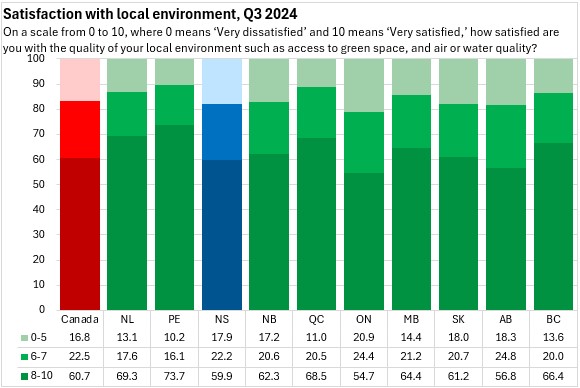
Satisfaction with the local environment appears to be declining in Nova Scotia (though this is infrequently assessed).
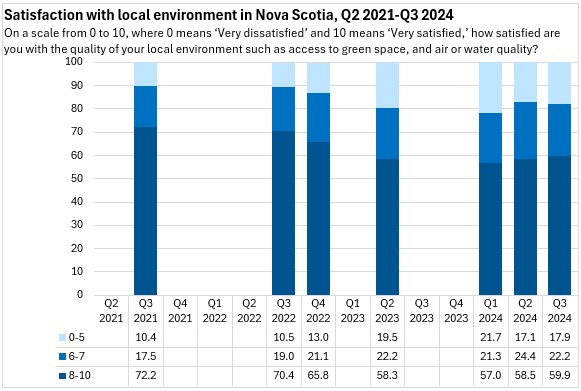
Confidence in Institutions
Confidence in institutions is measured on a scale from 1 to 5.
Canadians generally reported higher levels of confidence in the police with somewhat lower levels of confidence for the justice/courts and school systems. Strong confidence in the Federal Parliament and Canada's media was less prevalent.
Respondents in Nova Scotia were least likely to report high levels of confidence in police.
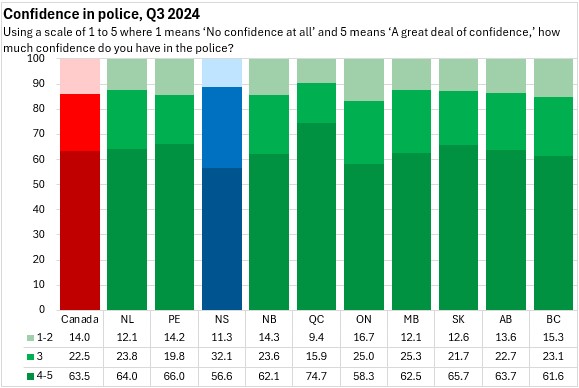
Over time, Nova Scotians' confidence in police appears to be shifting from the highest to more moderate levels.

British Columbia and Newfoundland and Labrador residents were less likely to express high confidence in justice and the courts.
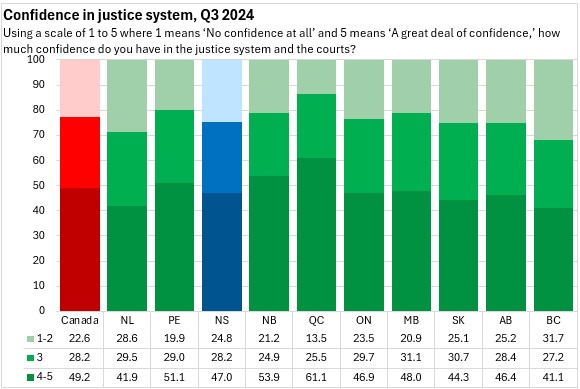
Nova Scotians' confidence in justice and the courts had been declining, but then started to improve in 2024.
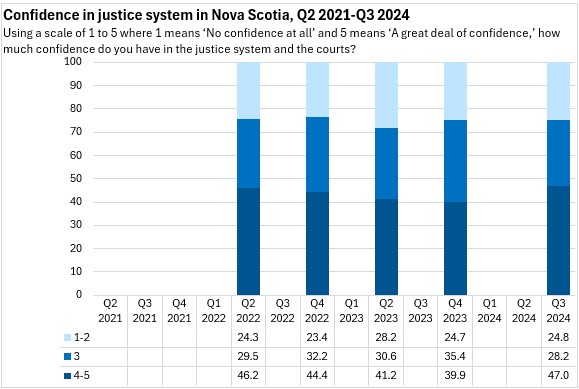
Nova Scotians were the least likely to report strong confidence in the school system. Residents in Québec and Prince Edward Island reported higher levels of confidence in their school systems.
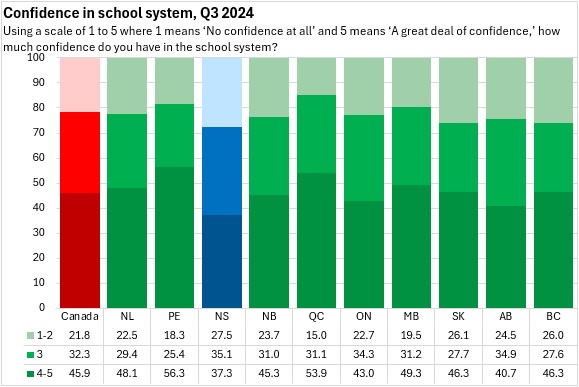
Nova Scotians' confidence in schools has been declining.
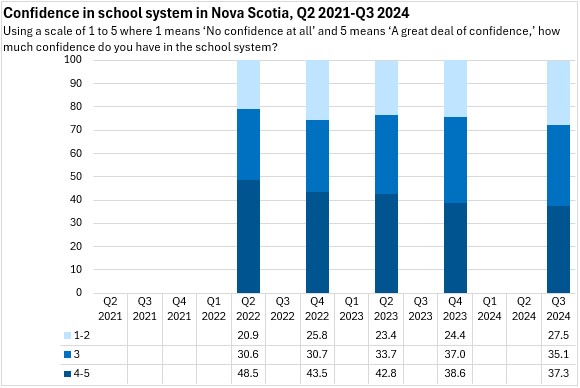
Nova Scotia's were also the least likely to report high confidence in Canada's Federal Parliament. Residents in Alberta and Saskatchewan reported wider prevalence of low confidence in Canada's Federal Parliament.

Nova Scotians' confidence in Federal Parliament has been falling, though some improvement was reported in 2024.
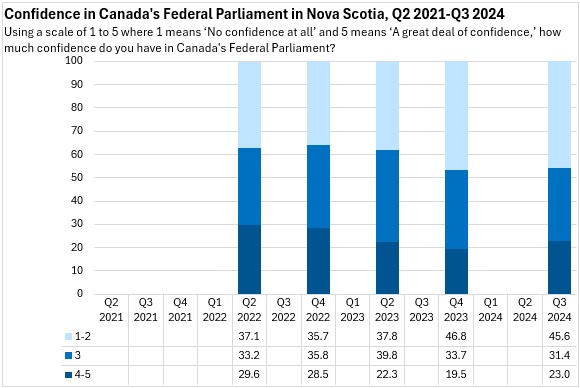
Respondents in Nova Scotia, Alberta and Saskatchewan also reported the least prevalence of high confidence in Canadian media. Respondents in Québec expressed higher confidence in Canadian media.

Nova Scotians' confidence in Canadian media has been deteriorating, though there was a small improvement in 2024.
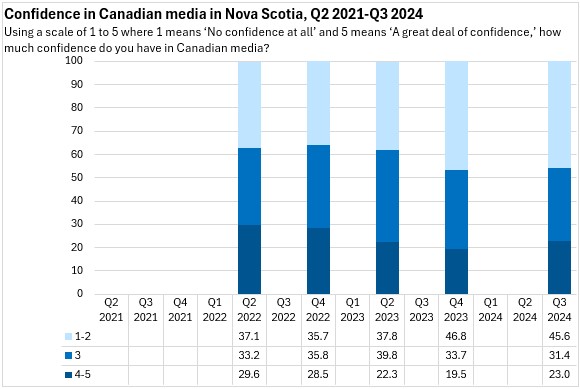
Trust in people
Outside of British Columbia and Saskatchewan, Nova Scotians were most likely to report trusting most people. Respondents in Québec and Newfoundland and Labrador were most likely to report that you cannot be too careful with people.
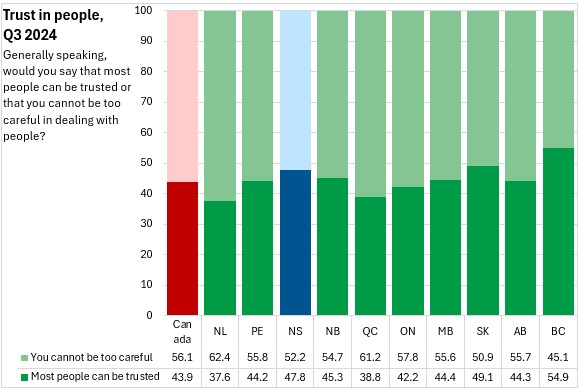
Although infrequently measured, Nova Scotians' trust in other people improved in 2024.
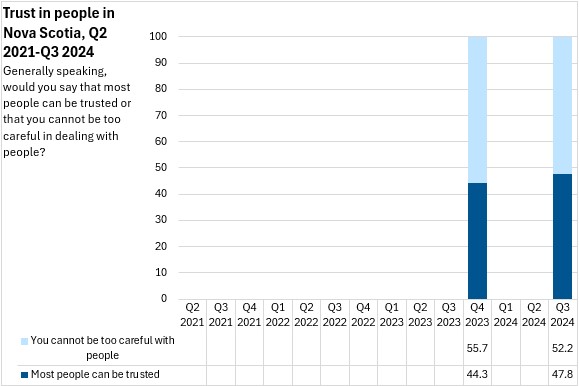
Discrimination
In Nova Scotia, 26.7% of respondents reported experiences of discrimination or unfair treatment while 73.3% of the population did not report these experiences. Across Canada, 30.9% of the population reported discrimination or unfair treatment, with higher prevalence in Ontario and the western provinces.
Among those that reported experiences of discrimination, the most common contexts were in workplaces or in public/retail spaces. In Nova Scotia, there were notably higher incidences of discrimination (among those that experienced it) in workplaces, on the internet, in health care settings as well as among family and friends.
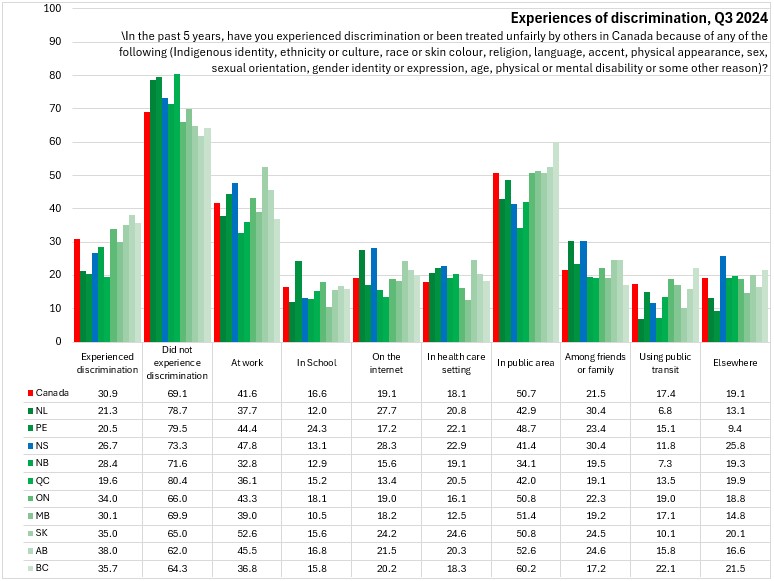
Although there is limited data, Nova Scotians' experiences of discrimination in school appear to have declined substantially while discrimination in workplace settings has been rising.
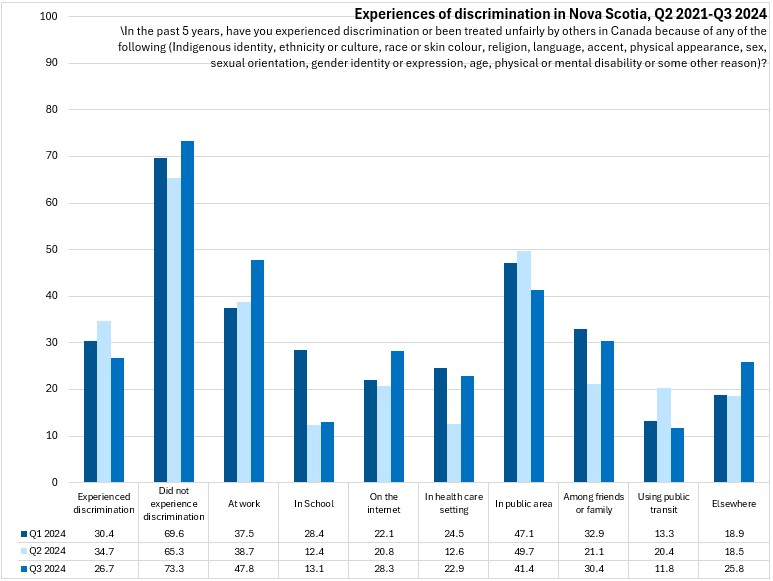
Across Canada, women were notably more likely to report experiencing discrimination or unfair treatment than were men. However, in Nova Scotia both men and women reported similar portions of the population that experienced discrimination.

Source: Statistics Canada. Table 13-10-0843-01 Life satisfaction by gender and province; Table 13-10-0845-01 Sense of meaning and purpose by gender and province; Table 13-10-0847-01 Future outlook by gender and province; Table 45-10-0048-01 Loneliness by gender and province; Table 45-10-0050-01 Having someone to count on by gender and province; Table 45-10-0052-01 Sense of belonging to local community by gender and province; Table 45-10-0067-01 Satisfaction with time use, by gender and province; Table 45-10-0069-01 Satisfaction with local environment, by gender and province; Table 45-10-0073-01 Confidence in institutions, by gender and province; Table 45-10-0098-01 General trust in people by gender and province; Table 45-10-0100-01 Discrimination and unfair treatment by gender and province
<--- Return to Archive